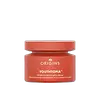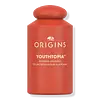What's inside
What's inside
 Key Ingredients
Key Ingredients

 Benefits
Benefits

 Concerns
Concerns

 Ingredients Side-by-side
Ingredients Side-by-side

Water
Skin ConditioningGlycerin
HumectantSqualane
EmollientCaprylic/Capric Triglyceride
MaskingIsoamyl Laurate
EmollientButyrospermum Parkii Butter
Skin ConditioningCetearyl Olivate
Pyrus Malus Seed Oil
EmollientMalus Domestica Fruit Cell Culture Extract
Skin ConditioningPyrus Malus Fiber
AbrasiveZingiber Officinale Root Extract
MaskingLaminaria Digitata Extract
Skin ProtectingLaminaria Saccharina Extract
Skin ProtectingLactobacillus Ferment
Skin ConditioningSodium Hyaluronate
HumectantCaffeine
Skin ConditioningOryzanol
Skin ConditioningTocopherol
AntioxidantGlycine Soja Oil
EmollientAcetyl Hexapeptide-8
HumectantEthylhexylglycerin
Skin ConditioningLecithin
EmollientButylene Glycol
HumectantResveratrol
AntioxidantSorbitan Olivate
EmulsifyingChamomilla Recutita Flower Oil
MaskingMentha Piperita Oil
MaskingCoriandrum Sativum Fruit Oil
MaskingCitrus Nobilis Peel Oil
MaskingMimosa Tenuiflora Leaf Extract
Skin ProtectingCitrus Aurantium Dulcis Peel Oil
MaskingCitrus Aurantium Bergamia Fruit Oil
MaskingCitrus Limon Peel Oil
MaskingRosa Damascena Flower Extract
MaskingRosa Damascena Flower Oil
MaskingMichelia Alba Flower Oil
MaskingCopaifera Officinalis Resin
MaskingFerula Galbaniflua Resin Oil
AntimicrobialJasminum Sambac Flower Extract
MaskingRicinus Communis Seed Oil
MaskingPelargonium Graveolens Flower Oil
MaskingLinalool
PerfumingCitral
PerfumingLimonene
PerfumingCitronellol
PerfumingGeraniol
PerfumingPEG-40 Stearate
EmulsifyingXanthan Gum
EmulsifyingCarbomer
Emulsion StabilisingPhenoxyethanol
PreservativePotassium Sorbate
PreservativeMica
Cosmetic ColorantCI 77891
Cosmetic ColorantWater, Glycerin, Squalane, Caprylic/Capric Triglyceride, Isoamyl Laurate, Butyrospermum Parkii Butter, Cetearyl Olivate, Pyrus Malus Seed Oil, Malus Domestica Fruit Cell Culture Extract, Pyrus Malus Fiber, Zingiber Officinale Root Extract, Laminaria Digitata Extract, Laminaria Saccharina Extract, Lactobacillus Ferment, Sodium Hyaluronate, Caffeine, Oryzanol, Tocopherol, Glycine Soja Oil, Acetyl Hexapeptide-8, Ethylhexylglycerin, Lecithin, Butylene Glycol, Resveratrol, Sorbitan Olivate, Chamomilla Recutita Flower Oil, Mentha Piperita Oil, Coriandrum Sativum Fruit Oil, Citrus Nobilis Peel Oil, Mimosa Tenuiflora Leaf Extract, Citrus Aurantium Dulcis Peel Oil, Citrus Aurantium Bergamia Fruit Oil, Citrus Limon Peel Oil, Rosa Damascena Flower Extract, Rosa Damascena Flower Oil, Michelia Alba Flower Oil, Copaifera Officinalis Resin, Ferula Galbaniflua Resin Oil, Jasminum Sambac Flower Extract, Ricinus Communis Seed Oil, Pelargonium Graveolens Flower Oil, Linalool, Citral, Limonene, Citronellol, Geraniol, PEG-40 Stearate, Xanthan Gum, Carbomer, Phenoxyethanol, Potassium Sorbate, Mica, CI 77891
Water
Skin ConditioningDicaprylyl Carbonate
EmollientHamamelis Virginiana Water
AstringentOctyldodecanol
EmollientPropanediol
SolventButylene Glycol
HumectantLactic Acid
BufferingPolysorbate 20
EmulsifyingSodium Hydroxide
BufferingGlycolic Acid
BufferingVinegar
Tartaric Acid
BufferingTrehalose
HumectantHydrogenated Lecithin
EmulsifyingPyrus Malus Fiber
AbrasiveMalus Domestica Fruit Cell Culture Extract
Skin ConditioningLactobacillus Ferment
Skin ConditioningZingiber Officinale Root Extract
MaskingOlea Europaea Fruit Extract
BleachingSalicylic Acid
MaskingGlucosamine Hcl
Betaine
HumectantFerula Galbaniflua Resin Oil
AntimicrobialLitsea Cubeba Fruit Oil
MaskingGlycine Soja Oil
EmollientGlycerin
HumectantPullulan
Sclerotium Gum
Emulsion StabilisingTocopherol
AntioxidantMaltodextrin
AbsorbentLecithin
EmollientCarbomer
Emulsion StabilisingXanthan Gum
EmulsifyingLinalool
PerfumingCitral
PerfumingFarnesol
PerfumingSodium Citrate
BufferingSilica
AbrasivePhenoxyethanol
PreservativeBenzoic Acid
MaskingWater, Dicaprylyl Carbonate, Hamamelis Virginiana Water, Octyldodecanol, Propanediol, Butylene Glycol, Lactic Acid, Polysorbate 20, Sodium Hydroxide, Glycolic Acid, Vinegar, Tartaric Acid, Trehalose, Hydrogenated Lecithin, Pyrus Malus Fiber, Malus Domestica Fruit Cell Culture Extract, Lactobacillus Ferment, Zingiber Officinale Root Extract, Olea Europaea Fruit Extract, Salicylic Acid, Glucosamine Hcl, Betaine, Ferula Galbaniflua Resin Oil, Litsea Cubeba Fruit Oil, Glycine Soja Oil, Glycerin, Pullulan, Sclerotium Gum, Tocopherol, Maltodextrin, Lecithin, Carbomer, Xanthan Gum, Linalool, Citral, Farnesol, Sodium Citrate, Silica, Phenoxyethanol, Benzoic Acid
 Reviews
Reviews

Ingredients Explained
These ingredients are found in both products.
Ingredients higher up in an ingredient list are typically present in a larger amount.
Butylene Glycol (or BG) is used within cosmetic products for a few different reasons:
Overall, Butylene Glycol is a safe and well-rounded ingredient that works well with other ingredients.
Though this ingredient works well with most skin types, some people with sensitive skin may experience a reaction such as allergic rashes, closed comedones, or itchiness.
Learn more about Butylene GlycolCarbomer is a polymer of acrylic acid. Its main role is to create a gel consistency.
A high amount of carbomer can cause pilling or balling up of products. Don't worry, most products contain 1% or less of carbomer.
Citral is a fragrance and used to add a lemon-like scent to products. It is both naturally found in plants and created synthetically. In plants, it is commonly occurring in lemon myrtle, lemongrass, lemon tea-tree, lemon verbena, and other citruses.
The EU mandates Citral be listed separately as a fragrance. It is a known allergen and may cause contact dermatitis. Citral can also used as a masking ingredient.
The term 'fragrance' is not regulated in many countries. In many cases, it is up to the brand to define this term. For instance, many brands choose to label themselves as "fragrance-free" because they are not using synthetic fragrances. However, their products may still contain ingredients such as essential oils that are considered a fragrance.
The term 'citral' is a collective term for two geometric isomers: geranial/Citral A and neral/Citral B.
Learn more about CitralFerula Galbaniflua Resin Oil is a fragrance and is an oil.
Glycerin is already naturally found in your skin. It helps moisturize and protect your skin.
A study from 2016 found glycerin to be more effective as a humectant than AHAs and hyaluronic acid.
As a humectant, it helps the skin stay hydrated by pulling moisture to your skin. The low molecular weight of glycerin allows it to pull moisture into the deeper layers of your skin.
Hydrated skin improves your skin barrier; Your skin barrier helps protect against irritants and bacteria.
Glycerin has also been found to have antimicrobial and antiviral properties. Due to these properties, glycerin is often used in wound and burn treatments.
In cosmetics, glycerin is usually derived from plants such as soybean or palm. However, it can also be sourced from animals, such as tallow or animal fat.
This ingredient is organic, colorless, odorless, and non-toxic.
Glycerin is the name for this ingredient in American English. British English uses Glycerol/Glycerine.
Learn more about GlycerinGlycine Soja Oil comes from the soybean. Glycine Soja is native to eastern Asia.
Soybean oil is an emollient. It is rich in antioxidants and fatty acids including palmitic, stearic, oleic, and linoleic acids.
As an emollient, the fatty acids in soybean oil helps keep your skin soft and hydrated. It does so by creating a film on top that traps moisture in.
Soybean oil is also rich in vitamin E, a potent antioxidant. Vitamin E is also anti-inflammatory and provides a soothing effect.
Studies show soy may help fade hyperpigmentation from UVB. It does so by disrupting the melanin process from UVB induced skin inflammation.
This ingredient may not be malassezia folliculitis, or fungal-acne, safe.
Soybeans are rich in proteins and are part of the legume family. Foods made with soybeans include tofu, soymilk, edamame, miso, and soy sauce.
Learn more about Glycine Soja OilLactobacillus Ferment is created by fermenting the Lactobacillus bacteria. It helps keep our skin's natural barrier and microbiome healthy.
Studies show lactobacillus ferment to be effective at repairing the skin barrier. Having a healthy skin barrier helps keep your skin healthy and hydrated. It also protects against bad bacteria.
As a probiotic/prebiotic/postbiotic, Lactobacillus ferment can help regular our natural biome. In fact, one study found a lack of diversity in our natural skin biome can trigger acne.
Learn more about Lactobacillus FermentLecithin is a term for a group of substances found in the cell membranes of plants, animals, and humans. They are made up of mixture of phospholipids.
This ingredient has emollient and emulsifying properties.
As an emollient, lecithen helps soften the skin and creates a barrier to keep moisture in.
As an emulsifier, it also helps prevent water and oil ingredients from separating. Lecithin can also help ingredients be better absorbed by the skin.
This is because the phospholipids in lecithin produce liposomes. Liposomes help other ingredients get through the skin barrier.
Depending on the source of this ingredient, lecithin may not be fungal acne safe. This is because some sources of lecithin come from soybean oil, which may feed the malassezia yeast that feeds fungal acne.
We recommend reaching out to the brand you are purchasing from to inquire about the source of their lecithin.
Some other names for this ingredient include soy lecithin and deoiled soy lecithin.
Learn more about LecithinLinalool is a fragrance and helps add scent to products. It's derived from common plants such as cinnamon, mint, citrus, and lavender.
Like Limonene, this ingredient oxidizes when exposed to air. Oxidized linalool can cause allergies and skin sensitivity.
This ingredient has a scent that is floral, spicy tropical, and citrus-like.
Learn more about LinaloolThis ingredient comes from a rare Swiss apple known as Uttwiler Spätlauber. It is produced from the cell cultures of the apple and not the fruit itself.
According to manufacturer studies, this ingredient has demonstrated the following benefits:
- Visible anti-wrinkle effect around the eye area (in vivo)
- Enhanced colony-forming efficiency of epidermal stem cells (in vitro)
- Improved ability of skin cells to regenerate and build new tissues in a 3D epidermis model (in vitro)
- Increased skin density (in vitro)
- Boosted vitality of epidermal stem cells (in vitro)
- Reversal of cellular aging signs in fibroblasts (in vitro)
Phenoxyethanol is a preservative that has germicide, antimicrobial, and aromatic properties. Studies show that phenoxyethanol can prevent microbial growth. By itself, it has a scent that is similar to that of a rose.
It's often used in formulations along with Caprylyl Glycol to preserve the shelf life of products.
Pyrus Malus Fiber is an exfoliant.
Tocopherol (also known as Vitamin E) is a common antioxidant used to help protect the skin from free-radicals and strengthen the skin barrier. It's also fat soluble - this means our skin is great at absorbing it.
Vitamin E also helps keep your natural skin lipids healthy. Your lipid skin barrier naturally consists of lipids, ceramides, and fatty acids. Vitamin E offers extra protection for your skin’s lipid barrier, keeping your skin healthy and nourished.
Another benefit is a bit of UV protection. Vitamin E helps reduce the damage caused by UVB rays. (It should not replace your sunscreen). Combining it with Vitamin C can decrease sunburned cells and hyperpigmentation after UV exposure.
You might have noticed Vitamin E + C often paired together. This is because it is great at stabilizing Vitamin C. Using the two together helps increase the effectiveness of both ingredients.
There are often claims that Vitamin E can reduce/prevent scarring, but these claims haven't been confirmed by scientific research.
Learn more about TocopherolWater. It's the most common cosmetic ingredient of all. You'll usually see it at the top of ingredient lists, meaning that it makes up the largest part of the product.
So why is it so popular? Water most often acts as a solvent - this means that it helps dissolve other ingredients into the formulation.
You'll also recognize water as that liquid we all need to stay alive. If you see this, drink a glass of water. Stay hydrated!
Learn more about WaterXanthan gum is used as a stabilizer and thickener within cosmetic products. It helps give products a sticky, thick feeling - preventing them from being too runny.
On the technical side of things, xanthan gum is a polysaccharide - a combination consisting of multiple sugar molecules bonded together.
Xanthan gum is a pretty common and great ingredient. It is a natural, non-toxic, non-irritating ingredient that is also commonly used in food products.
Learn more about Xanthan GumZingiber Officinale is more commonly known as ginger.
Ginger root has antioxidant, anti-inflammation, and antimicrobial properties.
The antioxidant properties help protect your body from free-radicals. Free-radicals are molecules that may damage your skin cells. As a result, ginger may help slow down signs of aging such as hyperpigmentation and wrinkles.
Studies show ginger inhibits the enzyme that breaks down collagen. It also helps with:
This ingredient has no negative side-effects and is safe to use unless one has a specific allergy to it.
Ginger originates from Southeast Asia but has spread throughout the world. It is now a common spice used in many cultures.
Learn more about Zingiber Officinale Root Extract